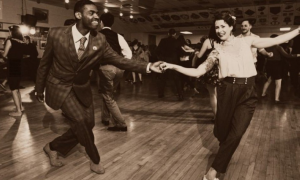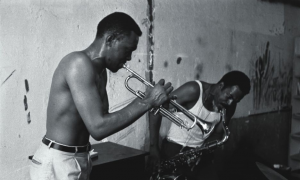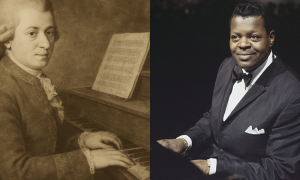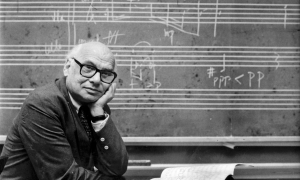Home » Jazz Articles » Opinion » With Friends Like These...
With Friends Like These...
So the initiatives become facility-based concepts with no other specific goals other than hoping something good will happen out of all those millions tossed on the table.
"It's no big thing to make a lot of money, if all you want to do is make a lot of money. (From Citizen Kane)
"More harm is done by fools through foolishness than by evildoers through wickedness. (Sufi saying)
This is the third in a series of pieces examining the current state of the jazz business and how we got here. In the first, Hello... I Must Be Going we saw that although nearly half a billion dollars has changed hands in the past 15 years to supposedly improve conditions, the scene for musicians has gotten significantly worse (unless of course, you buy into the Republican economic philosophy that a tiny percentage receiving the bulk of the benefits signifies a healthy economy).
In the second part, Prelude to a Kiss-off, we looked at how during the late '70s and early '80s the potential for true artist self-empowerment and expanded opportunity was a tangible near-reality. At the conclusion of that piece, I pointed to the circumstances that brought about the complete reversal of that potential and created an entirely new landscape of exploitation from a completely unanticipated enemy - the Fine Arts and Culture establishment. I also mentioned that I, our organization Outward Visions, and a number of similarly dedicated colleagues were entirely overlooked in the planning of the new funding initiatives. We'll go into why a little later, but first it's important to consider two very basic and disturbing facts to get a true understanding of why all this has occurred:
- The world of Fine Arts and Culture does not understand, respect or even like the art form of Jazz, or its creators.
- The advocates and professionals to whom they listen and consistently employ in their various Jazz-related projects have neither the ability nor the desire to actually improve conditions for Jazz artists.
Pretty harsh statements, huh? Maybe, but not nearly as harsh as the reality that has been set in motion through the actions of various bozos from both of these camps.
Consider also (for those of you who haven't bothered to check my credentials for the validation of my perspective), my direct experience in dealing with these Arts and Culture folks. This has been done from both the Jazz perspective as well as from my representation of high-level artists in Dance and Contemporary Music. I can directly attest to an enormous difference in attitude toward Jazz from this world.
Oh, they claim to have great respect for "America's Greatest Indigenous Art Form and all that yabba dabba doo, but engage almost any of them on even the most basic understanding of the music and its creators and you'll find they wouldn't know the difference between Mingus and a dingus.
Consider this: fine arts professionals and presenters often have a direct and major influence upon Jazz-based initiatives simply because they know something about the art form, or because they include a few events a year among the dozens of presentations that make up their overall programming. Do you think George Wein would be allowed to influence Dance funding because he presented some concerts featuring tap dancers; or that Anthony Braxton or Ornette Coleman could be influential upon Western Classical initiatives because of their own forays into that discipline? No way, no how.
(A tiny caveat here - if you speak with folks who toil in these other disciplines today, they will also state that the same problems of facility-based funding, anointed darlings, presenters as stars, and the rich-get-richer syndrome are fully at play in their domains also. However, each of these art forms already had certain structures and methodologies in place prior to the '80s. Jazz only made it into this arena during the '80s. Therefore, its entire context is totally under the influence of this most unfortunate current trend.)
But all of this can be neatly summed up by the Ken Burns Jazz fiasco, in which arts funders stumbled all over each other in their desire to throw money into that boondoggle's $15+ million budget. Can you imagine them dropping any other fine art form into the hands of a filmmaker whose entire experience with it was having "maybe a couple of records in (his) sizable collection ? Never happen. Never. I don't know about you, but if I was laying out the scratch to establish a new franchise in the NBA, I wouldn't be hiring a GM or coach whose entire experience consisted of watching "maybe a couple of games on television.
As for the professionals that they bring to the table over and over again as consultants, advisors, participants, administrators and spewers of their "vast knowledge and expertise - isn't it about time that some of these folks began to deliver something that benefited anyone other than themselves and each other? Even if they had the vision to accomplish anything, it's highly unlikely that they'd ever put it in motion. After all, that would make them obsolete. Like they say about cancer - they'll never find a cure for it as long as there's more money in searching for the cure than in finding it. So these useless folks are more than content to stroke the funders and massage their egos by telling them what great things they're all doing for Jazz. Meanwhile, these placebo advocates can then strut around at conferences, festivals, awards ceremonies and whatnot with their fellow wastes of space, posturing, expounding and otherwise filling the air with their worthless and flatulent contributions to the overall pollution.
For real perspective, a little quiz:
Off the top of your head and in three minutes (no research in books, liner notes, the Internet, etc.), name as many important non-musicians as you can who had a truly meaningful influence on Jazz prior to 1950. (Pause) My guess is that unless you have an extremely overloaded knowledge of Jazz history, very few of you will be able to name more than two or three, if that. Now do the same with musicians. (Pause) I bet they shot out like bullets from an Uzi, and that you could go on for another five minutes at the same pace.
And that's the way it's supposed to be.
Producers, presenters, clubowners, managers, agents, record business executives, and the vast majority of writers are nothing but functionaries and facilitators for the truly essential component of this art form - the musicians. You're not supposed to know who we are. We are supposed to be behind the scenes and stay there. Occasionally (and very rarely), an Alfred Lion, a Rudy Van Gelder, a Norman Granz, a Nat Hentoff emerge and make a mark that is truly meaningful. That's because they did (do) their jobs out of love and for the joys and satisfaction intrinsically entailed; not for the sake of their own aggrandizement.
We have become a culture of starfuckers and if we can't reach the stars we want, we'll manufacture the ones we can. When it comes to the Paris Hiltons, Jessica Simpsons and Regis Philbins of popular culture, it's an old story. But when it occurs in the domain that is supposed to be built upon the legacies of John Coltrane, Duke Ellington, Charlie Parker and Miles Davis, it is a shameful travesty.
Musicians have never ruled the economic strata of Jazz, but until recently, they did control the music. Now they've lost even that. And the only way they're going to get it back is for musicians, their representatives and the truly committed advocates to throw the phonies, poseurs and related weasels out of the house and into the gutters where they belong.
If that means losing the extremely rare, high paying gig, so be it. If that means ostracizing an anointed mediocrity who's being rammed down the throats of an indifferent, ignorant public, so be it. If it means calling out some cheap hustlers who cover their fat asses with an oversized race card, see it for the deuce it really is and call them on it. If some arrogant junior George Wein, who wouldn't know A flat from B cool, tries to force you into some arbitrary context, contrived collaboration or sit-up-and-beg posture, get into his or her face like Mingus, Miles or Betty would have. There is no Jazz business without Jazz musicians; and even more importantly, there will be no Jazz future unless today's musicians are ready to bring the same level of commitment, pride and power to the table that the great members of the Pantheon brought in the past. That means that they need to bring back Truth into the music and into the entire domain in which it's created. Whatever the cost will be, it cannot be as great as the cost is going to be if things continue the way they are going now.
I keep hearing that the things I've been saying here in these writings are the same things that musicians have been saying privately and behind closed doors for decades. It's time that they start saying them out in the open.
I'm guessing that 'round about now some of you think I've answered the question as to why I was left out of the process when the recent initiatives were being developed (when the loot was being divvied up would be a more appropriate description).
After all, who would want a muthafucka with an attitude like mine at the table. In fact, one particular professional actually told me recently that it was the hardcore things I write that have kept me out of the process. My response to him was "you mean that I was left out of these initiative sessions in the mid to late '80s because they knew I was going to start writing these pieces in the late '90s?
You see, attitudes like mine do not come about for no reason. Nor could the things we accomplished (as stated in the last piece I wrote) in the late '70s and early '80s have been done if I had been filled with the anger, frustration, pessimism and general sense of hopelessness about the Jazz scene that I have right now.
The real reason that I, and others with similar viewpoints were left out of the process is because the current trends would never have been put in motion if we'd been part of it. Instead, truly worthwhile elements such as a focus on artist empowerment through the development of distribution systems for artist-controlled product, the establishment and support of artist-driven 501(c)(3) non-profits (as are standard for all other fine arts forms), touring networks of cooperative-based presenters (like most of those we helped establish in the late '70s), and other similarly artist-oriented concepts would have been brought to the table. And most of all, there would have been an equitable division of the funding that was about to be provided.
But that would have stood in the way of the exploitative, arrogant and self-serving mechanisms that have resulted in the various fiefdoms and monoliths that provide good jobs and related benefits for a variety of (primarily) non-musicians, along with ego-gratification and lordly control by a small group of failed ones as to who gets to perform and when, where and for how much.
So was this the plan from Jump Street? Even I'm not cynical enough to really believe that. I also believe that a number of folks, such as Holly Sidford, who initiated the Lila Wallace Network when she was in charge there, truly wanted to do something meaningful for the art form. But people are extremely susceptible to the betterment of their own self-interests. Mix in a few phony hustlers, who for one reason or another are able to talk their way around their own incompetence and lack of vision, and a few others who will go along with anything to cover up their own lack of sustenance, and then top it off with a few musicians willing to rubber-stamp anything that might produce a leg up or even a few more gigs; and you have a recipe for potential disaster. When that cake pops out of the oven, ice it with that grand ol' Amurrikan, bigger is better/gimme more philosophy as is so perfectly represented by Lincoln Center - and that recipe becomes a reality that poisons everything else with which it comes into contact.
So the initiatives become facility-based concepts with no other specific goals other than hoping something good will happen out of all those millions tossed on the table. But with no specific goals, no overall purpose and not even any standards by which the various facilities were supposed to function on a mutual basis, any real potential of systemic progress was dead from the outset. And with Lincoln Center as the symbolic Castle in the Sky, only corruption could result.
The most damaging element is the synthetic economic environment that was created, maintaining no semblance of the true economics of the Jazz marketplace. Probably the most significant issue was that the cooperatively structured sponsors, where a number of dedicated individuals came together to present the music and develop related educational outreach, mutated into monolithic structures under the iron-handed direction of single, salaried executives who fancy themselves as visionaries. These folks - almost all white guys - must have all learned from the same book, as they are uniformly arrogant, self-centered and unwilling to cooperate with smaller presenters in their region or even each other. Unless of course it's advantageous to themselves. Now, through the Lila Wallace and the follow-up Doris Duke programs they have become powerful, monolithic overlords (with one notable exception, The Hartford Artists Collective, under the guidance of Dollie and Jackie McLean - duh), with their own endowments of anywhere from $500,000 to $1,000,000.
Every musician, agent, manager and committed professional to whom I've spoken display nothing but contempt for these guys, but none of them will say it publicly because they are afraid of offending them and depriving themselves of the gigs they bestow. Not exactly the healthiest of atmospheres for positive development is it? The sad irony is that without the musicians these guys have nothing, yet this handful of punks is allowed to control their ability to work.
So, is this what the Wallace and Duke programs were supposed to create - jobs for a dozen executives and their staffs with some trickle down money for the artists upon whom they deign to bestow the occasional gig? Does it benefit the scene that they can now throw high-paying gigs ($30-40K) to the anointed few, and occasionally pay the worthy masters $10-20K, but that the standard gigs to the rank and file are 30-50% lower than those some cities were paying them 25 years ago, (and considerably fewer besides)?
So, the reasonably well-paying gig ($4-10,000) - upon which a multi-city tour could be built, developing the artist's audience, opening new markets, increasing product sales along with general visibility, and without putting smaller, more dedicated presenters at too much risk - has been virtually eliminated in exchange for the occasional high-paying gig (at the whim of the plantation heads). The bottom line? Fewer gigs, less people to be directly touched by the music, and less money in the hands of the musicians.
As for the sucker bait line of musicians finally getting paid the kind of money they deserve - isn't it better to have a healthy and balanced regular diet rather than gorging oneself on the occasional feast?
Next time, we'll take a look at the myths and the corresponding truths to the various plans, initiatives and promises that are being spun by today's Jazz business hierarchy and their stooges with the same disdain for honesty and truth as the way Fox News toadies up to the Bush regime.
'til then,
Peace & A Love Supreme
Marty Khan
Discuss With Friends Like These... on the AAJ Bulletin Board.
Tags
PREVIOUS / NEXT
Support All About Jazz
 All About Jazz has been a pillar of jazz since 1995, championing it as an art form and, more importantly, supporting the musicians who make it. Our enduring commitment has made "AAJ" one of the most culturally important websites of its kind, read by hundreds of thousands of fans, musicians and industry figures every month.
All About Jazz has been a pillar of jazz since 1995, championing it as an art form and, more importantly, supporting the musicians who make it. Our enduring commitment has made "AAJ" one of the most culturally important websites of its kind, read by hundreds of thousands of fans, musicians and industry figures every month.




















